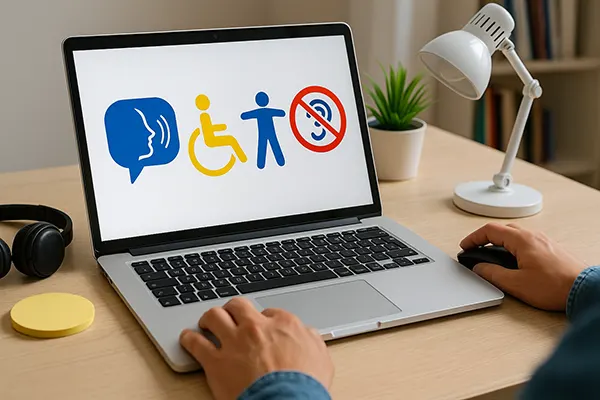
Web Accessibility 2025: How to Comply with the New WCAG 3.0 Standards
Web accessibility has become an increasingly critical aspect of digital design, and in 2025, the release of WCAG 3.0 introduced a new level of complexity and clarity. For businesses, developers, and content creators, the question is no longer whether to comply but how to ensure digital spaces are inclusive for everyone. WCAG 3.0 isn’t just an update—it’s a fundamental shift in approach, structure, and evaluation. This article explores what has changed, what remains consistent, and how organisations can align with the latest guidance.
Understanding the Core Principles of WCAG 3.0
The Web Content Accessibility Guidelines (WCAG) 3.0, published by the W3C in a working draft, builds on the foundation laid by WCAG 2.2 but introduces broader and more flexible principles. While the previous versions used binary pass/fail criteria, WCAG 3.0 introduces a more nuanced, outcome-based scoring model. This shift better reflects real-world user experiences and accessibility barriers. The guidelines are now framed to support a wider range of disabilities, including cognitive and learning disabilities.
Unlike WCAG 2.x, which used Success Criteria under POUR principles (Perceivable, Operable, Understandable, Robust), WCAG 3.0 introduces Outcomes, which are measured against a rating scale from 0 to 4. This allows for more comprehensive evaluation and improvement over time. For instance, an interface might partially meet accessibility goals and be scored accordingly, instead of failing outright.
The 2025 version also incorporates more guidance for assistive technologies and inclusive design. It supports innovations in user testing and encourages organisations to document how they evaluate accessibility within their processes. This ensures a more dynamic and adaptive approach to inclusivity.
Why This Matters More Than Ever in 2025
With growing global legislation on digital accessibility—such as the European Accessibility Act (EAA), the updated Section 508 in the United States, and similar mandates in Canada and Australia—compliance with WCAG 3.0 is no longer optional for many sectors. Non-compliance could result in lawsuits, loss of public trust, or the exclusion of key user demographics, particularly people with disabilities.
Moreover, inclusivity in digital services is increasingly tied to ethical responsibility and brand reputation. Users are more likely to engage with and trust organisations that proactively support accessibility. The WCAG 3.0 framework provides the technical and philosophical structure to achieve this, but it requires strategic implementation.
Companies in 2025 are therefore not only expected to implement accessible design but also demonstrate it with audits, user feedback, and transparent scoring based on WCAG 3.0. Accessibility is no longer a background task—it must be integrated into every phase of product development and content creation.
Key Technical Changes Introduced by WCAG 3.0
WCAG 3.0 moves away from rigid checklists and toward a performance-based model. One of the major shifts is the introduction of “Guidelines” instead of “Success Criteria.” Each guideline includes multiple outcomes and methods for testing. For example, the guideline on text alternatives includes outcomes related to screen reader usability and user comprehension, not just the presence of alt text.
Another major update is the inclusion of conformance ranges (Bronze, Silver, and Gold), allowing organisations to demonstrate progress and gradual improvement rather than absolute compliance. Bronze is the new minimum threshold, which replaces the older Level A/AA/AAA model from WCAG 2.x. This allows for more realistic and flexible compliance paths.
Testing in WCAG 3.0 is also more inclusive. It combines automated tools, manual expert reviews, and usability testing with people with disabilities. This is a major improvement, as previous guidelines sometimes failed to reflect practical user experiences. It ensures a more human-centred and experience-based approach to evaluating accessibility.
What Developers and Designers Should Do Differently
Developers need to prioritise semantic HTML, responsive layouts, and flexible user interfaces. The new guidelines stress the need to evaluate content in different contexts—screen readers, low vision modes, cognitive tools, and alternative input devices. Tools such as WAVE, Axe, and Lighthouse must now be used in conjunction with user-based testing to meet conformance levels under WCAG 3.0.
Designers should revisit colour contrast, interactive elements, font sizes, and navigation clarity. But more importantly, they should participate in inclusive testing cycles. Prototypes and early design iterations should be evaluated by diverse user groups, including people with cognitive and motor impairments, to identify issues early.
Additionally, both roles must become comfortable with outcome-based feedback. Instead of checking if a button has a label, the goal is to ensure users understand the label and can interact with it effortlessly. It’s about user experience, not just technical correctness.

Implementing Accessibility Across Teams and Workflows
Accessibility must become a shared responsibility across content, design, and engineering teams. WCAG 3.0 promotes a cultural shift: it encourages accessibility as a continuous process, not a one-time compliance exercise. That requires training, shared documentation, regular audits, and stakeholder accountability at all levels.
One best practice is to integrate accessibility into Agile workflows. Every user story should include accessibility criteria, and every sprint should involve accessibility testing. Accessibility backlogs should be visible, prioritised, and tracked like any other critical issue. Accessibility champions should be appointed across departments to ensure distributed ownership.
Organisations should also invest in accessibility audits and certification. External validation, combined with internal processes, strengthens legal compliance and user trust. Training materials, onboarding documentation, and performance reviews should reflect accessibility goals to embed them into team culture and KPIs.
Resources and Tools for Maintaining Compliance
Several tools and frameworks now support the implementation of WCAG 3.0. These include the WAI Evaluation Tools List, WCAG 3.0 draft documentation, and open-source auditing tools like Pa11y and Tenon. For testing with users, platforms like Fable and AccessWorks offer remote user testing with people with disabilities.
Additionally, content management systems such as WordPress and Drupal have plugins and themes optimised for accessibility. GitHub repositories also provide checklists and templates for maintaining accessibility documentation. Investing in training through W3C’s accessibility courses can help teams stay updated and certified.
Finally, accessibility statements must be transparent and up to date. WCAG 3.0 recommends publishing conformance scores, methodology, and plans for improvement. This level of transparency aligns with the principles of trustworthiness and accountability, critical elements of E-E-A-T in 2025.
